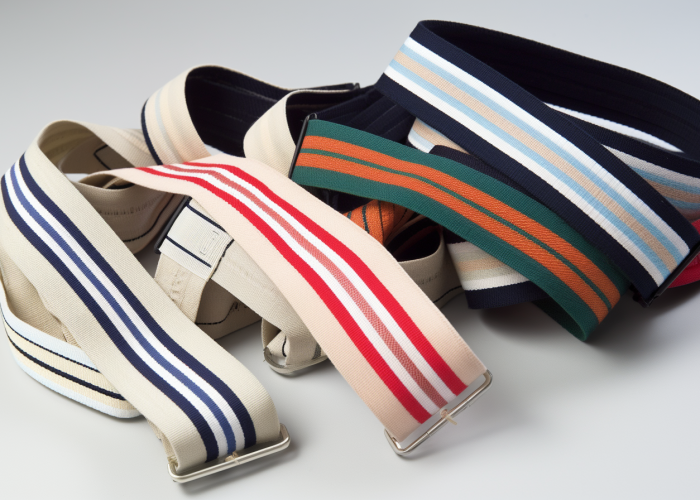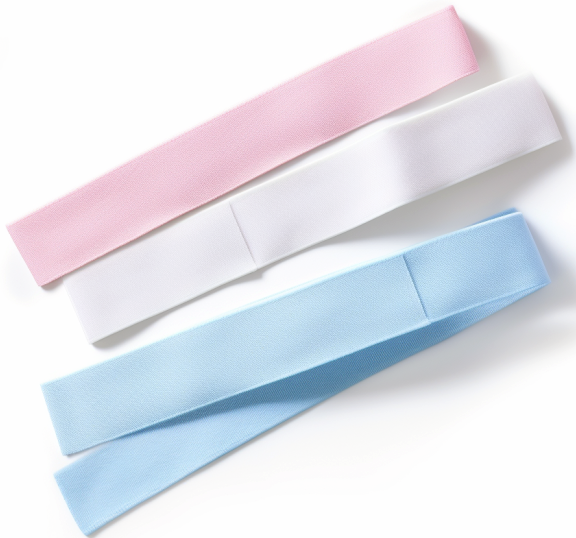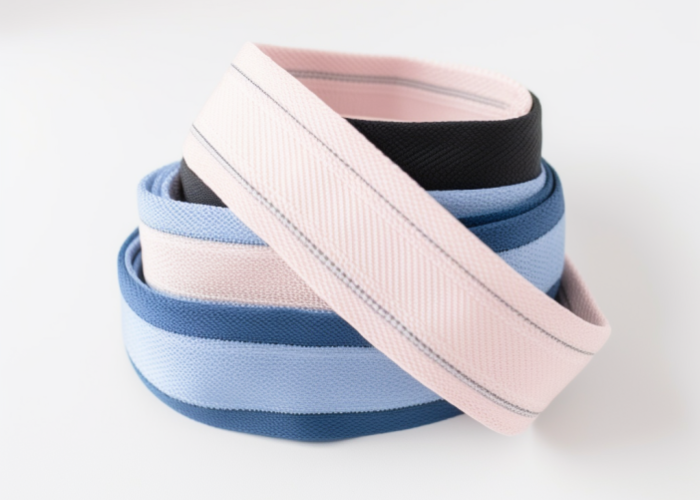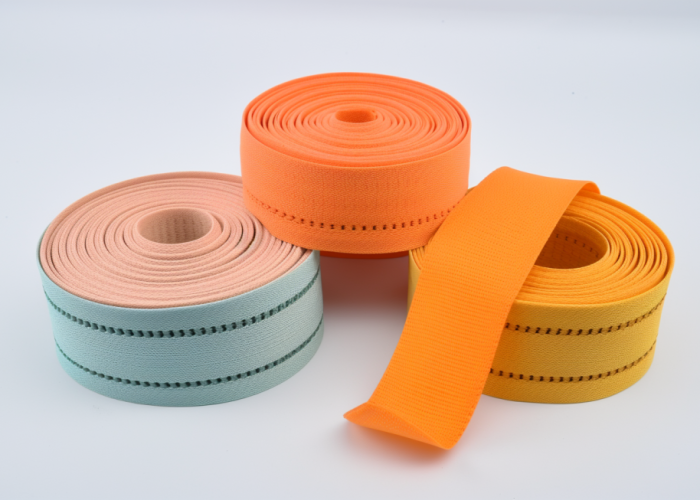Selecting appropriate webbing materials is crucial for products requiring hypoallergenic properties. Latex-free webbing delivers elastic performance without allergy risks, while custom manufacturing solutions enable product developers to meet specific compliance standards and performance requirements.
Latex-free webbing is a hypoallergenic alternative to rubber latex webbing, made from materials like synthetic polyurethane or thermoplastic elastomers. It offers similar stretch and durability without triggering latex allergies.
Explore the key properties, applications, and material considerations of latex-free webbing to help you choose the ideal solution for your product development needs.


Webbing manufacturing expert with 15+ years of experience helping product developers build high-performance straps for industrial, medical, and outdoor use.
Latex-free webbing features 100% hypoallergenic composition, 300-600% elongation rates, 25-30% higher UV resistance than natural latex, and tensile strengths from 200-800 lbs for elastic variants and up to 3000 lbs for non-elastic options. These measurable advantages make it ideal for applications where performance specifications, longevity, and allergen concerns are critical factors.
AT A GLANCE
Compliance: Meets ISO 10993, ANSI/AAMI, and OSHA standards for medical and safety applications
USED IN
Hypoallergenic composition represents the primary advantage of latex-free webbing, with laboratory testing confirming complete absence of the 15 proteins identified as allergens in natural rubber latex. This elimination of allergenic compounds makes these materials suitable for direct skin contact in medical devices, athletic equipment, and apparel, reducing liability concerns while ensuring user safety across all applications.
Superior environmental performance gives latex-free alternatives a significant edge over natural latex in challenging conditions. Testing demonstrates 25-30% higher resistance to UV degradation, 40% greater chemical resistance, and improved performance in temperature extremes (-40°F to 225°F vs. -10°F to 180°F for natural latex). These properties translate directly to extended product lifespans and reduced replacement cycles, particularly in outdoor and industrial applications.
Manufacturing precision enables synthetic webbing to achieve tightly controlled specifications with variances of less than ±0.02″ in width and ±0.01″ in thickness. This consistency allows product engineers to design with confidence, knowing that performance characteristics remain stable throughout production runs. Advanced weaving techniques further enable custom patterns with specialized properties like controlled stretch zones or reinforced edges.
Latex-free webbing solves critical industry challenges by eliminating allergic reactions in medical settings, providing 25-30% longer lifespan in outdoor applications, maintaining dimensional stability in varying conditions, and meeting stringent regulatory requirements for specialized equipment. These solutions directly address pain points across multiple sectors where traditional latex webbing creates complications or fails to meet performance standards.
AT A GLANCE
USED IN
In medical settings, latex-free webbing eliminates allergic reactions affecting 17% of healthcare workers and 1-6% of patients. Synthetic alternatives maintain necessary elasticity for tourniquets and restraints while removing all protein allergens verified through ASTM D6499 testing.
For outdoor products, enhanced resistance extends lifespans significantly. Testing shows synthetic webbing maintains 90% of properties after 5,000 hours of accelerated weathering, versus 50-60% for natural latex. This delivers 2-3 times longer service life, reducing warranty claims and replacement costs.
Industrial applications benefit from superior chemical stability. Synthetic webbing maintains 85% of tensile strength after exposure to oils and solvents that degrade natural latex by 40-60%. This enables use in environments previously unsuitable for elastic webbing.
In safety systems, consistent aging characteristics provide predictable performance. Tensile strength degrades linearly rather than showing the sudden property changes common with natural latex. This predictability improves safety margins and maintenance scheduling for critical applications.
Important considerations for latex-free webbing include verifying complete absence of latex contamination (below 50ppm), understanding specific temperature performance ranges (-40°F to 225°F for most variants), recognizing width tolerance variations (±0.02″), evaluating recovery rates (80-95% depending on material), and confirming appropriate certifications for end-use applications. These factors are critical when selecting latex-free alternatives to ensure they meet both technical requirements and compliance standards.
AT A GLANCE
Complete latex elimination requires strict manufacturing controls. Even trace amounts of latex protein (50ppm) can trigger reactions in sensitive individuals. When selecting materials for medical applications, request documentation of contamination prevention protocols and material verification testing.
Performance characteristics vary between different alternatives. Thermoplastic elastomers provide 80-85% recovery after stretching, compared to 90-95% for synthetic polyurethane and 75-80% for PVC-based options. These differences are critical in applications requiring precise tension or repeated stretching.
Environmental resistance profiles should match application requirements. While most latex-free options offer superior UV protection, their chemical resistance varies significantly. Polyurethane excels with petroleum products but may degrade faster in certain solvents. Match material properties to expected exposures for optimal performance.
Cost considerations range from 5-15% premium for basic PVC alternatives to 25-40% for high-performance polyurethane formulations. However, these differences must be balanced against extended service life, reduced replacement needs, and elimination of latex management protocols when calculating true lifecycle costs.

Latex-free webbing offers 100% elimination of allergen proteins compared to natural latex, provides 25-30% higher UV resistance, delivers 15-20% better chemical resistance, functions across a wider temperature range (-40°F to 225°F vs. -10°F to 180°F), and meets stringent medical standards without requiring special handling protocols. While natural latex retains slight advantages in initial cost (20-30% lower) and maximum elongation (up to 750% vs. 600%), the performance and safety benefits of latex-free alternatives increasingly outweigh these factors.
AT A GLANCE
Material composition represents the fundamental difference between these webbing types. Traditional latex contains proteins from the Hevea brasiliensis tree that trigger allergic reactions. Synthetic alternatives deliver similar properties without allergenic proteins, providing complete elimination of allergy risk.
Performance testing reveals key differences. Natural latex achieves higher maximum elongation (750% vs. 600%) and sometimes better initial recovery. However, latex-free alternatives maintain properties longer under environmental stress, retaining 80-90% of original properties after UV exposure that degrades natural latex to 50-60%.
Longevity testing shows significant advantages for synthetic options. Accelerated aging demonstrates that latex-free alternatives maintain functional properties approximately 40% longer under identical conditions. This extended life translates directly to reduced replacement frequency and more consistent performance throughout the product lifecycle.
Manufacturing consistency is superior with synthetic materials. Production testing shows lower batch-to-batch variation in tensile strength (±5% vs. ±10-15%), thickness (±0.01″ vs. ±0.02″), and elongation. This consistency allows more precise engineering specifications and reduces over-design requirements, enabling more efficient product development.
Synthetic polyurethane rubber provides the best performance for medical applications requiring 90-95% recovery and biocompatibility, thermoplastic elastomers (TPE) excel in consumer products needing 300-400% elongation with 80-85% recovery, polyvinyl chloride (PVC) offers cost-effective solutions for light-duty applications with 150-200% elongation, and neoprene delivers superior chemical resistance for industrial environments. Selecting the optimal latex-free material requires matching specific performance characteristics to application requirements rather than using a one-size-fits-all approach.
AT A GLANCE
Synthetic polyurethane rubber excels in medical and safety applications. Its molecular structure delivers 400-600% elongation with 90-95% recovery after repeated stretching. It passes ISO 10993 biocompatibility testing with no cytotoxicity or sensitization effects, making it ideal for direct skin contact in orthopedic supports where precise tension is crucial.
Thermoplastic elastomers (TPE) balance performance and cost for consumer applications. With 300-400% elongation and 80-85% recovery, these materials deliver good functionality at 10-15% lower cost than polyurethane. TPE compounds can be customized for hardness, texture, and color, making them suitable for fitness equipment and consumer goods.
PVC elastomer blends offer economical solutions for light-duty applications. With 150-200% elongation and lower recovery rates, they carry the lowest price point (5-10% above natural latex). While not suitable for high-performance uses, they provide excellent value for products with occasional stretching needs or limited environmental exposure.
Specialty elastomers address niche requirements. Neoprene delivers superior resistance to petroleum products for industrial environments with oil exposure. EVA blends provide a soft, comfortable feel with moderate stretch (200-300%) for applications where user comfort is paramount. These materials cost 20-30% more but deliver performance unavailable with standard alternatives.

Latex-free webbing is safe for medical applications, meeting ISO 10993 biocompatibility requirements with no cytotoxicity, skin irritation, or sensitization effects, eliminating the 1-6% allergic reaction risk of natural latex, and complying with FDA Class I and II medical device standards. Medical-grade formulations undergo rigorous testing to ensure safety for direct patient contact in surgical, orthopedic, and therapeutic applications while maintaining necessary performance characteristics.
AT A GLANCE
Biocompatibility testing confirms the safety of medical-grade latex-free webbing. These materials undergo rigorous evaluation according to ISO 10993 standards, including cytotoxicity (ISO 10993-5), skin irritation (ISO 10993-10), and systemic toxicity (ISO 10993-11). Test results consistently show no adverse biological reactions across temporary to prolonged-use applications.
Allergen elimination provides critical safety advantages. Natural latex contains at least 15 allergenic proteins that can trigger reactions from mild dermatitis to anaphylaxis. Medical-grade latex-free webbing undergoes ASTM D6499 testing to verify complete protein absence, making these materials suitable even for highly sensitive patients.
Chemical stability during sterilization ensures ongoing safety. Testing shows properly formulated latex-free webbing maintains integrity through ethylene oxide, gamma irradiation, and autoclave treatments without leaching harmful compounds. This stability preserves safety profiles through multiple sterilization cycles, unlike some latex products that degrade during reprocessing.
Regulatory documentation simplifies approval processes. Manufacturers provide comprehensive packages including master files for FDA submissions, detailed composition information, and certification of standards compliance. This documentation supports efficient regulatory submissions and helps device manufacturers address labeling requirements regarding latex content.
Custom manufacturing capabilities for latex-free webbing include precision width production from 0.25″ to 4″ with ±0.02″ tolerance, material formulations engineered for specific elongation rates from 150-600%, specialized weave patterns for controlled directional stretch, custom colors matching Pantone specifications, and production quantities from 500-foot sampling runs to full-scale manufacturing. These customization options enable product developers to obtain precisely engineered webbing that meets specific performance requirements rather than adapting designs to off-the-shelf materials.
AT A GLANCE
Material formulation customization enables precise performance tuning for specific applications. Through polymer selection and process controls, latex-free webbing can be engineered with elongation from 150% to 600% and recovery from 70% for single-use to 95% for critical reusable products. This allows engineers to specify exact performance requirements rather than compromising with standard formulations.
Structural variations enhance functionality beyond basic designs. Advanced manufacturing enables controlled stretch zones with different elongation properties in a single piece, reinforced edges for improved durability at attachment points, and engineered stretch limiters that prevent overextension. These features allow designers to integrate sophisticated performance directly into the webbing itself.
Aesthetic customization satisfies both functional and brand requirements. Custom coloration using FDA-compliant pigments achieves precise Pantone matching, while specialized printing enables permanent marking with logos or measurement indicators that remain legible when stretched. These options allow webbing to serve both functional and branding purposes simultaneously.
Production scalability accommodates development from prototyping through commercialization. Manufacturing capabilities include limited runs (500-1,000 feet) for testing, medium-scale production (5,000-10,000 feet) for market validation, and full-scale capacity for established products. This allows developers to maintain material consistency throughout the development process without changing suppliers as volumes increase.

Latex-free webbing provides superior performance, safety, and longevity while eliminating allergy risks. When selecting materials, consider application requirements, performance needs, and lifecycle costs rather than initial price alone. Contact us to explore custom manufacturing solutions tailored to your specific product requirements, from material formulation to specialized structural features that optimize performance.
Truly latex-free webbing contains zero natural rubber latex proteins verified through ASTM D6499 testing. Request documentation confirming protein absence (below 50ppm), dedicated manufacturing processes, and contamination prevention protocols from your supplier.
Yes, latex-free webbing typically costs 10-40% more than natural latex initially. However, the total lifecycle cost is often lower due to 30-50% longer service life, reduced replacement frequency, and elimination of latex management protocols in sensitive applications.
Latex-free webbing typically functions across temperatures from -40°F to 225°F. This broader temperature range significantly outperforms natural latex (-10°F to 180°F), making synthetic alternatives superior for extreme environment applications.
Yes, latex-free materials for medical applications must meet ISO 10993 biocompatibility standards. Additionally, ASTM D6499 testing verifies the absence of allergenic proteins, while specific applications may require compliance with FDA, ANSI, or OSHA standards.
Most latex-free alternatives provide 300-600% elongation compared to natural latex’s 750%. While slightly less elastic at maximum stretch, synthetic alternatives maintain their elastic properties longer under environmental stress and repeated stretching cycles.
Custom latex-free webbing is available starting at 500-foot minimum runs for prototyping purposes. Development quantities of 5,000-10,000 feet support market validation, while full production capabilities accommodate established product manufacturing needs.